MessageToEagle.com – Mysterious paintings in France’s Chauvet Caves – one of the world’s most famous caves – are believed to depict the oldest-known depiction of a volcanic eruption.
The paintings were created by early humans 36,000 years ago and were discovered in 1994.
The depictions appeared in Chauvet Cave at around the same time as nearby volcanoes spewed lava high into the sky, researchers report in a paper published this month in PLoS ONE.

Sebastien Nomade, a geoscientist at the University of Paris-Saclay in Gif-Sur-Yvette, France, who led the study, visited Bas-Vivarais in 2012 and sampled rock from three volcanic centers. Nomade and his team measured the levels of different isotopes of radioactive argon gas and determined that the region had been lit up by a series of eruptions between about 19,000 years and 43,000 years ago.
The events would have been dramatic ‘strombolian’ eruptions, Nomade says — named after those typical of the Stromboli volcano in Italy — with lava spewing 200-plus metres into the sky and flowing down the volcanoes’ slopes. Each cone would have erupted once or twice before going extinct,
He and his team members measured the levels of different isotopes of radioactive argon gas in the samples, and determined that the region had been lit up by a series of strombolian eruptions between 19,000 and 43,000 years ago.
Strombolian eruptions, named for Italy’s Stromboli volcano, spew lava more than 200 yards into the sky.
“You just have to climb the small hill on top of Chauvet, and looking north you see the volcanoes. During the night you could see them glowing and you could hear the sound of the volcanic eruption,” Nomade told Nature News.
He adds that there’s no way to prove that the images depict volcanic eruptions, “but for us it’s the hypothesis which is the most probable.”
If researchers are correct, Chauvet’s volcano imagery would represent the earliest record of any eruption. Other, younger examples include a mysterious 8,600-year-old mural found on a wall at the Neolithic site of Çatalhöyük in central Turkey, which may be a map depicting a nearby volcano that erupted at around that time2. And the poet Pliny the Younger famously documented the ad 79 eruption of Vesuvius (which took the life of his uncle, Pliny the Elder).
MessageToEagle.com
source: Nature News







